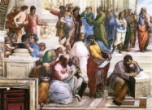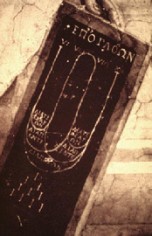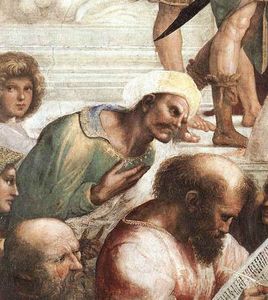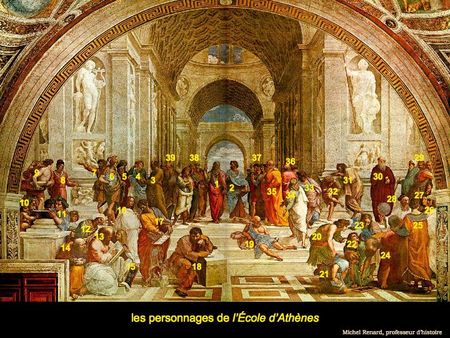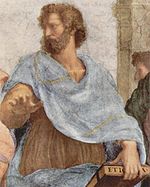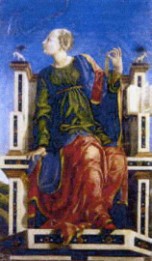Hi Mikeh
1.
In chapter III, Gosselin focuses on the harmonic progression from unity (1) of the Four diapasons :
1+2+4+8+16 = 31 specific of the game le Trente et Un. (Rabelais's Trente et Ung).
viewtopic.php?f=11&t=1102&start=160#p17344
It is
Nicomachus Book I Chapter 8
Translation and drawing of the Harmonic proportion : pp 192 - 196 in
https://drive.google.com/file/d/0B5Hg6j ... sp=sharing
Nicomachus of Gerasa, Introduction to Arithmetic, English translation by Martin Luther D’Ooge,
with Studies in Greek Arithmetic, by Fank Egleston Robbins and Louis Charles Karpinski,
London: Macmillan and Company, Ltd., 1916.
https://ia600709.us.archive.org/27/item ... hmetic.pdf
Did Gosselin refer implicitely to Nicomaque or translators or commentators when he mentions in his Epistre the
"quelques Philosophes Pythagoriques"?
2.
In reality Gosselin's presentation of Numbers and Musical intervals is more complex and exhaustive than the last Harmonic proportion from Nicomaque's Book I Chapter 8 applied to the Game of Trente et Un of the 52 ordinary cards :
1+2+4+8+16 ....
Before in Chapters I and II, he offers a more complex and detailled presentation of proportions of Numbers and their relations to musicals intervals
Gosselins Pythagorean presenation of proportions and musicals intervals and Nicomaque de Gerase , see my post on :
viewtopic.php?f=11&t=1102&p=17250&hilit=gosselin#p17250
Followed by your's :
viewtopic.php?f=11&t=1102&p=17250&hilit=gosselin#p17256
Specifically Gosselin's writing :
1. Les Nombres et leurs 7 proportions ( en réalité 14 en comptant les sous-proportions à chaque fois)
viewtopic.php?f=11&t=1102&p=17211&hilit=gosselin#p17211
2. Proportions des Nombres en relation avec les intervalles musicaux
viewtopic.php?f=11&t=1102&p=17235&hilit=gosselin#p17235
These seems taken directly from Nicomaque
Numbers and proportions
Book I chapter XVII to XXIII
Book II
chapter I -V
chapter XVIII- XXIX
3.
In his EPISTRE Gosselin lists 3 sources for his work : PLATON, Aristote and "quelques philosophes Pythagoriques".
Quote in extenso :
[traduction libre et approximative en Français modernisé] :
[Dédicace]
A Monseigneur (...) d' Esparnon, Duc, Pair de France, Premier Gentilhomme de la chambre du Roy, et Colonel général de l' Infanterie Française
EPISTRE
Page 3
Monseigneur,
Les Mathématiques, à raison de l'utilité, et du contentement, qu'elles apportent aux hommes, ont été anciennement en si grande estime qu'on les faisait apprendre aux enfants aussi qu'ils avaient quelque
Page 4
peu de jugement
auparavant qu'ils commencent à étudier aux autres sciences humaines. Suivant laquelle coutume, nul n'était reçu pour disciple capable de
la philosophie divine de Platon, s 'il n'était suffisamment savant en Mathématique, pour laquelle cause,
le dit philosophe divin, avait fait écrire sur l'entrée de son Académie cette sentence : 'Que) Nul ignorant en géométrie n'entre (ici)
Et à la vérité, il n'est pas possible de bien entendre aucune science quelle qu'elle soit, sans la connaissance des Mathématiques. Pareillement, l' homme ne peut bien faire aucune action corporelle, qu'il ne pratique (suivant sa lumière naturelle) quelque raison ou opération de Mathématique ; [...]
Page 7
Et d'autant Monseigneur que je connais la bonne affection que vous avez aux Mathématiques, et le grand plaisir que vous prenez à les entendre, je me suis (décidé) de mettre par écrit, une certaine cogitation et recherche, que j'avais faite par ci-devant sur l'ancien jeu des chartes : afin d'en faire un présent (cadeau) à votre excellence ; lequel présent en apparence (est) peu de choses : mais si on y veut regarder de près, on trouvera qu il découvre de très beaux secrets de Mathématiques lesquels ont été cachés aux hommes depuis longtemps jusqu'à présent.
J'estime que ceux qui entendront ce mien discours, auront l'occasion d'en savoir gré à votre excellence.
Or, il convient de noter que les personnes qui jouent en ce jeu des chartes tâchent chacun pour sa part à retirer à soi les nombres, qui sont paints aux chartes par images et caractères : afin qu'ils puissent réduire et disposer, en certaines proportions et harmonies, les plus grandes qu'il est possible
Page 8
d'être aux dits nombres : voulant en cela imiter Nature, laquelle selon certaines proportions et harmonies des qualités élémentaires, produit toute chose naturelle; et la conserve en son être sans lesquelles proportions et harmonies, aucune chose naturelle ne peut durer.
Nous appelons (comme le fait
Aristote) chose naturelle, tout ce qui est composé de matière Elémentaire, et de forme : comme sont les hommes, les bêtes, les plantes, les pierres et autres choses.
je peux dire avec quelque raison que ce jeu des chartes est venu de l' intuition de
quelques Philosophes Pythagoriques : et que c'est chose digne d'être considérée, comment les Anciens avaient les mathématiques si familiaires, qu'ils s'en aidaient en toutes leurs affaires d'importance, et davantage quand ils voulaient jouer, ils s'appliquaient à quelque jeu rempli des fruits de(s) Mathématiques, tels que le dit jeu des Chartes, lequel représente par nombres proportionnels, la composition et tempérament de chaque chose naturelle.
L' Arithmomachie, laquelle représente une bataille entre les nombres pairs et les nombres impairs : qui tendent chacun à cette fin, de pouvoir gagner par nombres proportionnels une très grande victoire; et aussi le jeu de Paume
(...)
Page 10 fin Epistre
This enumeration is identical in Nicomaque listing in his Arithmetic Book II chapter XXII
CHAPTER XXII
I "The first three proportions[Note],' then, which are acknowledged by all
the ancients, Pythagoras, Plato, and Aristotle, are the arithmetic,
geometric, and harmonic; and there are three others subcontrary to
them, which do not have names of their own, but are called in more
general terms the fourth, fifth, and sixth forms of mean; after which
the moderns discover four others as well, making up the number ten,l
which, according to the Pythagorean view, is the most perfect possible.
It was in accordance with this number indeed that not long ago the ten
relations 2 were observed to take their proper number, the so-called ten
categories,3 the divisions and forms of the extremities of our hands and
feet, and countless other things which we shall notice in the proper
place.'
[Note]
Iamblichus adds concerning the history of the proportions (p. 100, 19): "But of old there
were but three means in the days of Pythagoras and the mathematicians of his time, the arithmetic,
the geometric, and the third in order, which was once called the subcontrary, but had its
name forthwith changed to hannonic by the schools of Archytas and Hippasus, because it seemed
to embrace the ratios that govern the harmonized and tuneful. And it was formerly called subcontrary
heeause its character was somehow subcontrary to the arithmetic. . •. After this name
had been changed, those who came later, Eudoxus and his school, invented three more means,
and called the fourth properly subcontrary because its properties were subcontrary to the harmonic
_ . • and the other two they named simply from their order, fifth and sixth. The ancients
and their successors thought that this number, i.e., six, of means could be set up; but the modems
have found four more in addition, devising their formation from the terms and the intervals."
Cf. also p. tI3, 16 tf. He adds (p. II6, I if.) that the first six were in use from Plato's time to
Eratosthenes, and that the other four were devised by Myonides and Euphranor, both Pythagoreans,
who lived later. Apparently Moderatus of Gades, as well as Nicomacbus, employed all
ten forms (see Proclus, In Tim., H. 18. 29 ff. Diehl).
Maybe I missed some other correlations.
What seems more and more likely is that Gosselin had these references at hand in his Royal Library.
Theon de Smyrne also gives these results ...
Exhaustive bibliographic references
Nicomachus of Gerasa, Introduction to Arithmetic, English translation by Martin Luther D’Ooge,
with Studies in Greek Arithmetic, by Fank Egleston Robbins and Louis Charles Karpinski,
London: Macmillan and Company, Ltd., 1916.
https://ia600709.us.archive.org/27/item ... hmetic.pdf
About Nicomaque de Gerase editions, I noted the followings :
Translators and commentators : Chapter IX
Manuscrts and tetxs of the Arithmetic : Chapter XI

